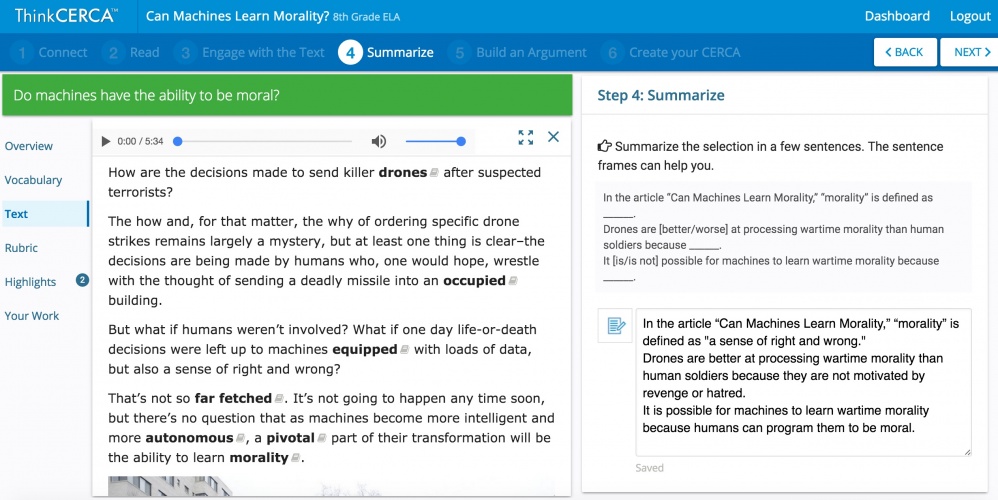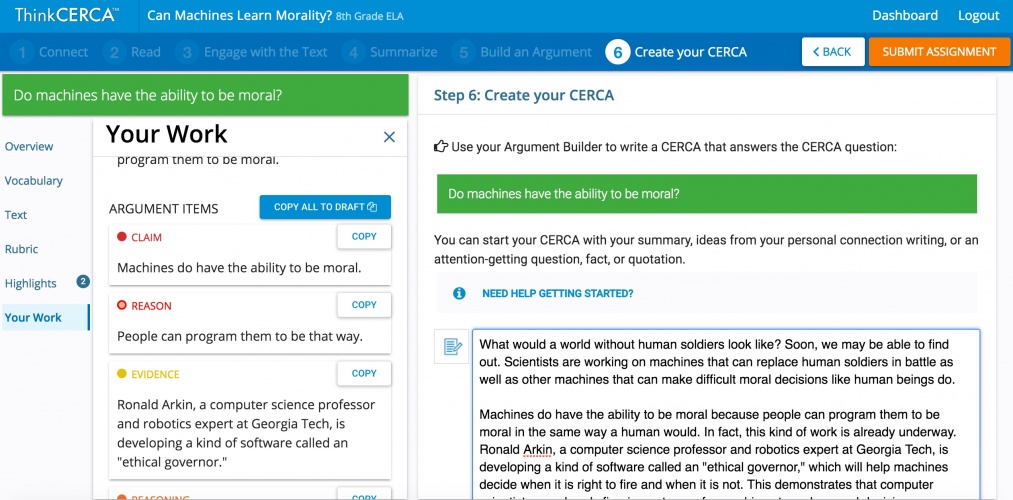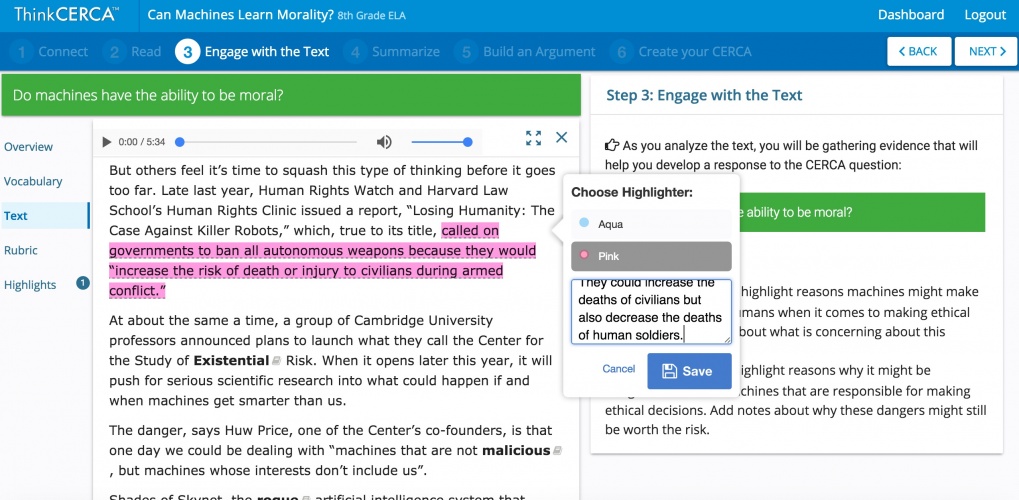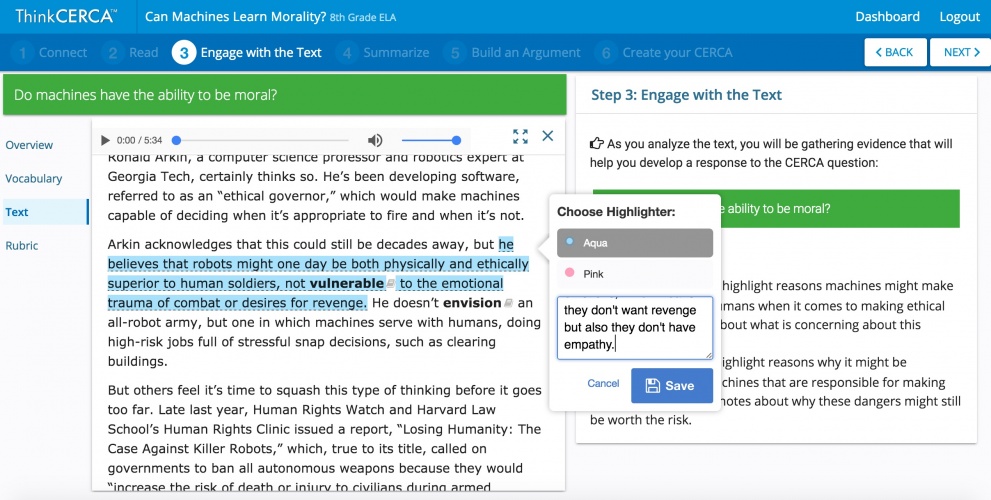Learning to process spoken and written information
Identify the main topic and retell key details of a text.
Describe the connection between two individuals, events, ideas, or pieces of information in a text.
Ask and answer questions to help determine or clarify the meaning of words and phrases in a text.
Know and use various text features to locate key facts or information in a text.
Distinguish between information provided by pictures or other illustrations and information provided by the words in a text.
Identify the reasons an author gives to support points in a text.
Recognize the distinguishing features of a sentence.
Read with sufficient accuracy and fluency to support comprehension.
Read grade-level text with purpose and understanding.
Recognize and read grade-appropriate irregularly spelled words.
Read grade-level text orally with accuracy, appropriate rate, and expression on successive readings.
Write opinion pieces in which they introduce the topic or name the book they are writing.
Write informative/explanatory texts in which they name a topic, supply some facts about the topic, and provide some sense of closure.
With guidance and support from adults, use a variety of digital tools to produce and publish writing.
With guidance and support from adults, recall information from experiences or gather information.
Ask and answer questions about key details in a text read aloud or information presented orally.
Produce complete sentences when appropriate to task and situation.
Demonstrate command of the conventions of standard English grammar and usage when writing or speaking.
Use sentence-level context as a clue to the meaning of a word or phrase.
Identify real-life connections between words and their use.
Cite strong and thorough textual evidence to support analysis of what the text says explicitly as well as inferences drawn from the text, including determining where the text leaves matters uncertain.
Determine two or more themes or central ideas of a text and analyze their development over the course of the text, including how they interact and build on one another to produce a complex account; provide an objective summary of the text.
Determine the meaning of words and phrases as they are used in the text, including figurative and connotative meanings; analyze the impact of specific word choices on meaning and tone, including words with multiple meanings or language that is particularly fresh, engaging, or beautiful. (Include Shakespeare as well as other authors.)
Analyze a case in which grasping a point of view requires distinguishing what is directly stated in a text from what is really meant (e.g., satire, sarcasm, irony, or understatement).
Determine two or more central ideas of a text and analyze their development over the course of the text, including how they interact and build on one another to provide a complex analysis; provide an objective summary of the text.
Analyze a complex set of ideas or sequence of events and explain how specific individuals, ideas, or events interact and develop over the course of the text.
Analyze and evaluate the effectiveness of the structure an author uses in his or her exposition or argument, including whether the structure makes points clear, convincing, and engaging.
Write arguments to support claims in an analysis of substantive topics or texts, using valid reasoning and relevant and sufficient evidence.
Introduce precise, knowledgeable claim(s), establish the significance of the claim(s), distinguish the claim(s) from alternate or opposing claims, and create an organization that logically sequences claim(s), counterclaims, reasons, and evidence.
Provide a concluding statement or section that follows from and supports the argument presented.
Write informative/explanatory texts to examine and convey complex ideas, concepts, and information clearly and accurately through the effective selection, organization, and analysis of content.
Produce clear and coherent writing in which the development, organization, and style are appropriate to task, purpose, and audience.
Develop and strengthen writing as needed by planning, revising, editing, rewriting, or trying a new approach, focusing on addressing what is most significant for a specific purpose and audience.
Draw evidence from literary or informational texts to support analysis, reflection, and research.
Use context (e.g., the overall meaning of a sentence, paragraph, or text; a word's position or function in a sentence) as a clue to the meaning of a word or phrase.
Demonstrate understanding of figurative language, word relationships, and nuances in word meanings.
Interpret figures of speech (e.g., hyperbole, paradox) in context and analyze their role in the text.
Ask and answer such questions as who, what, where, when, why.
Identify the main topic of a multiparagraph text as well as the focus of specific paragraphs within the text.
Describe the connection between a series of historical events, scientific ideas or concepts.
Determine the meaning of words and phrases in a text relevant to a grade 2 topic or subject area.
Know and use various text features to locate key facts or information in a text efficiently.
Identify the main purpose of a text, including what the author wants to answer, explain, or describe.
Describe how reasons support specific points the author makes in a text.
Read and comprehend informational texts, including history/social studies, science, and technical texts.
Write opinion pieces in which they introduce the topic or book they are writing about and state an opinion.
Write informative/explanatory texts in which they introduce a topic and use facts and definitions to develop points.
With guidance and support from adults and peers, focus on a topic and strengthen writing as needed by revising and editing.
Recount or describe key ideas or details from a text read aloud or information presented orally or through other media.
Produce complete sentences when appropriate to task and situation in order to provide requested detail or clarification.
Produce, expand, and rearrange complete simple and compound sentences.
Determine or clarify the meaning of unknown and multiple-meaning words and phrases.
Ask and answer questions to demonstrate understanding of a text, referring explicitly to the text as the basis for the answers.
Determine the main idea of a text; recount the key details and explain how they support the main idea.
Determine the central message, lesson, or moral of a text.
Determine the meaning of words and phrases as they are used in a text, distinguishing literal from nonliteral language.
Distinguish their own point of view from that of the narrator or those of the characters.
Describe the logical connection between particular sentences and paragraphs in a text.
Use context to confirm or self-correct word recognition and understanding, rereading as necessary.
Write opinion pieces on topics or texts, supporting a point of view with reasons.
Introduce the topic or text they are writing about, state an opinion, and create an organizational structure that lists reasons.
Provide reasons that support the opinion.
Use linking words and phrases to connect opinion and reasons.
Provide a concluding statement or section.
Write informative/explanatory texts to examine a topic and convey ideas and information clearly.
Use temporal words and phrases to signal event order.
Produce writing in which the development and organization are appropriate to task and purpose.
With guidance and support from peers and adults, develop and strengthen writing as needed by planning, revising, and editing.
Distinguish the literal and nonliteral meanings of words and phrases in context.
Refer to details and examples in a text when explaining what the text says explicitly and when drawing inferences from the text.
Explain events, procedures, ideas, or concepts in a historical, scientific, or technical text.
Determine the meaning of words and phrases as they are used in a text, including those referring to characters of mythology.
Describe the overall structure of events, ideas, concepts, or information in a text or part of a text.
Explain how an author uses reasons and evidence to support particular points in a text.
Read and comprehend informational texts, including history/social studies, science, and technical texts with scaffolding as needed at the high end of the range.
Write opinion pieces on topics or texts, supporting a point of view with reasons and information.
Introduce a topic or text clearly and create an organizational structure in which related ideas are grouped to support the writer’s purpose.
Provide reasons that are supported by facts and details.
Link opinion and reasons using words and phrases.
Provide a concluding statement or section related to the opinion presented.
Use precise language and domain-specific vocabulary to inform about or explain the topic.
Provide a concluding statement or section related to the information or explanation presented.
Produce clear and coherent writing in which the development and organization are appropriate to task, purpose, and audience.
Take notes and categorize information, and provide a list of sources.
Choose words and phrases to convey ideas precisely.
Consult reference materials to find the pronunciation and determine the precise meaning of key words and phrases.
Quote accurately from a text when explaining what the text says explicitly and when drawing inferences from the text.
Explain the relationships or interactions between two or more individuals, events, idea, or in technical text.
Determine the meaning of words and phrases as they are used in a text, including figurative language.
Describe how a narrator’s or speaker’s point of view influences how events are described.
Read and comprehend informational texts independently and proficiently.
With guidance develop and strengthen writing as needed by planning, editing or trying a new approach.
Summarize or paraphrase information in notes and finished work, and provide a list of sources.
Use context as a clue to the meaning of a word or phrase.
Consult reference materials to find the pronunciation and determine the meaning of key words and phrases.
Determine a theme or central idea of a text and how it is conveyed through particular details.
Provide a summary of the text distinct from personal opinions or judgments.
Analyze in detail how a key individual, event, or idea is introduced, illustrated, and elaborated in a text.
Determine the meaning of words and phrases as they are used in a text, including figurative and connotative meanings.
Determine an author’s point of view or purpose in a text and explain how it is conveyed in the text.
Explain how an author develops the point of view of the narrator or speaker in a text.
Read and comprehend literature proficiently, with scaffolding as needed at the high end of the range.
Determine a central idea of a text and how it is conveyed through particular details; provide a summary of the text distinct from personal opinions or judgments.
Determine the meaning of words and phrases as they are used in a text, including figurative, connotative, and technical meanings.
Determine an author's point of view or purpose in a text and explain how it is conveyed in the text.
Introduce claim(s) and organize the reasons and evidence clearly.
Write arguments to support claims with clear reasons and relevant evidence.
Support claim(s) with clear reasons and relevant evidence, using credible sources and demonstrating an understanding of the topic or text.
Use words, phrases, and clauses to clarify the relationships among claim(s) and reasons.
Provide a concluding statement or section that follows from the argument presented.
Write informative/explanatory texts to examine a topic and convey ideas, concepts, and information through the selection, organization, and analysis of relevant content.
Introduce a topic; organize ideas, concepts, and information, using strategies such as definition, classification, comparison/contrast, and cause/effect; include formatting (e.g., headings), graphics (e.g., charts, tables), and multimedia when useful to aiding comprehension.
Produce clear and coherent writing in which the development, organization, and style are appropriate to task, purpose, and audience. (Grade-specific expectations for writing types are defined in standards 1-3 above.)
Provide a concluding statement or section that follows from the information or explanation presented.
Being encouraged to link what they read or hear read to their own experiences.
Discussing word meanings, linking new meanings to those already known.
Explain clearly their understanding of what is read to them.
Discussing and clarifying the meanings of words, linking new meanings to known vocabulary.
Identifying main ideas drawn from more than one paragraph and summarising these.
Identifying how language, structure, and presentation contribute to meaning.
Retrieve and record information from non-fiction.
Summarising the main ideas drawn from more than one paragraph, identifying key details that support the main ideas.
Identifying how language, structure and presentation contribute to meaning.
Retrieve, record and present information from non-fiction.
Distinguish between statements of fact and opinion.
Provide reasoned justifications for their views.
Explain and discuss their understanding of what they have read, including through.
Writing narratives about personal experiences and those of others (real and fictional).
Writing for different purposes.
Writing down ideas and/or key words, including new vocabulary.
Make simple additions, revisions and corrections to their own writing by evaluating their writing with the teacher and other pupils.
Plan their writing by discussing and recording ideas.
Draft and write by organising paragraphs around a theme.
Draft and write in non-narrative material, using simple organisational devices [for example, headings and sub-headings].
Plan their writing by identifying the audience for and purpose of the writing, selecting the appropriate form and using other similar writing as models for their own.
Plan their writing by noting and developing initial ideas, drawing on reading and research where necessary.
Designing and producing own written content and textual representations
Learning to construe/process texts and written content
Understanding written assignments
Practicing listening skills and textual comprehension
Ask and answer questions about key details in a text.







User reviews for ThinkCERCA
You need to log in to post a review.